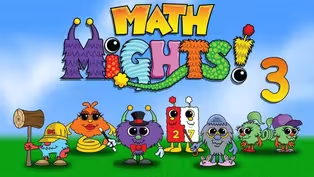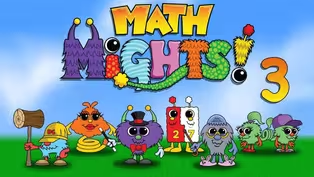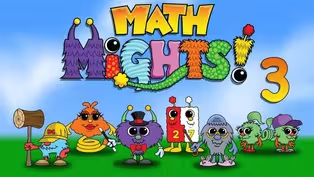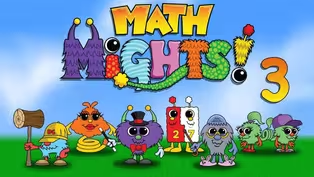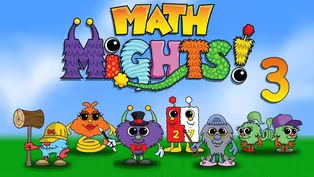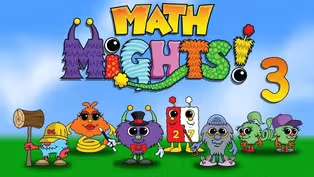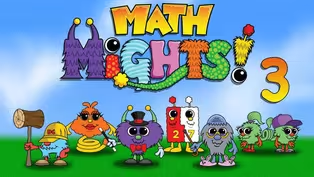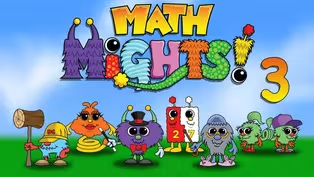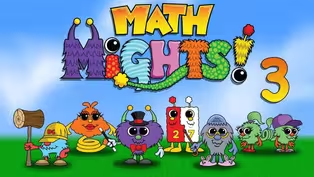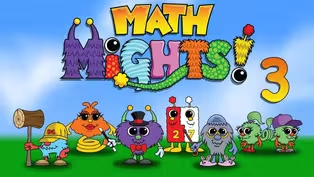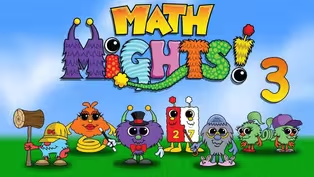Math Mights
Name the Parts of Fractions
Season 3 Episode 307 | 15m 59sVideo has Closed Captions
Join Ms. Askew for a division word problem with her friend Professor Barble.
Join Ms. Askew for a division word problem with her friend Professor Barble. Next, get ready to start to explore fractions by learning about partitioning parts of a whole!
Problems playing video? | Closed Captioning Feedback
Problems playing video? | Closed Captioning Feedback
Math Mights is a local public television program presented by Detroit PBS
Math Mights
Name the Parts of Fractions
Season 3 Episode 307 | 15m 59sVideo has Closed Captions
Join Ms. Askew for a division word problem with her friend Professor Barble. Next, get ready to start to explore fractions by learning about partitioning parts of a whole!
Problems playing video? | Closed Captioning Feedback
How to Watch Math Mights
Math Mights is available to stream on pbs.org and the free PBS App, available on iPhone, Apple TV, Android TV, Android smartphones, Amazon Fire TV, Amazon Fire Tablet, Roku, Samsung Smart TV, and Vizio.
Providing Support for PBS.org
Learn Moreabout PBS online sponsorshipMore from This Collection
Video has Closed Captions
Join Ms. Askew for a tricky multi-step word problem with Professor Barble! (15m 59s)
Build Fraction from Unit Fractions
Video has Closed Captions
Join Ms. Askew for another multi-step word problem with Professor Barble! (15m 59s)
Video has Closed Captions
Join Ms. Askew for a division word problem with her friend Professor Barble. (16m)
Video has Closed Captions
Join Ms. Askew and Professor Barble to do a visual model with a word problem. (15m 59s)
Dividing with even larger numbers
Video has Closed Captions
Join Ms. Askew and Professor Barble to do a visual model with multiplication. (15m 59s)
Video has Closed Captions
Join Ms. Askew and Professor Barble to see if you can match visual models to word problems (15m 59s)
Dividing with Larger Quotients
Video has Closed Captions
Join Ms. Askew and Professor Barble to see if you can match visual models to word problems (15m 59s)
Video has Closed Captions
Learn about multiplying one-digit whole numbers by multiples of 10. (15m 59s)
Video has Closed Captions
Learn about multiplying numbers larger than 20. (16m)
Video has Closed Captions
Join Mrs. Askew for a Number Talk with 2 Math Might Friends! (16m)
Multiply Teen Numbers with Larger Groups
Video has Closed Captions
Join Mrs. Askew for a Number talk with 2 Math Might Friends! (15m 59s)
Relating Multiplication and Division
Video has Closed Captions
Join Ms. Askew for a subtraction number talk with Springling! (16m)
Providing Support for PBS.org
Learn Moreabout PBS online sponsorship(upbeat music) - [Kids] "Math Mights".
- Welcome 3rd Grade Math Mights my Friends.
My name is Ms.Askew, and I am so happy that you joined us today.
Are you ready to have fun with Math?
I sure am.
So let's check out our plan for today.
Today, we're going to do a word problem with our friend Professor Barble.
After the word problem, we're gonna learn about how to name parts of a whole.
But before we begin let's warm up our brains with Professor Barble, as we conquer word problems using visual models.
Now you might be asking yourself, "What is a visual model?"
Well, a visual model is sometimes known as a model drawing, unit bar, tape diagram, or bar model.
It's a reading comprehension strategy for word problems.
Drawing a visual model helps to visualize the strategies and understand what the word problem is asking.
I think we should call our friend Professor Barble to help us with our word problem for today.
(upbeat music) Now, Professor Barble is a Math Might friend who likes to take hikes all throughout Mathville looking for word problems to solve.
On his hikes he discovered that we oftentimes rush into solving problems without even thinking.
His job is to slow us down so that we can follow a step-by-step process so that we can work through what the problem is asking us.
When he solving those problems, a thinking cap goes on his head and I sterling line comes out so that he could help us create a visual model for the problem.
Now Kimi and Noah I have a problem, let's see what it is today so that they can conquer it with Professor Barble.
"Ron brought a box of 36 balloons to the party.
"He gave each person four balloons.
"How many people got balloons?"
Well Kimi thinks in order to solve the problem we should maybe multiply.
Noah says, "or we can even divide."
Now, wait a minute, if professor Barble heard us talking, he would say, "You have dumped right into step six "which is to find a solution.
"We need to slow down "and follow the step-by-step process "so that we aren't guessing "when we try to figure out what the problem is asking."
These seven steps will help you as 3rd graders to have a better understanding of what a word problem is asking.
Let's start with step one.
And step one, we're gonna read the entire problem and we're gonna chunk the important parts of the story.
I want you to follow along with me as we read and we're gonna chunk as we go when we recognize what's important in the story problem.
"Ron brought a box of 36 balloons to the party."
Now that's important to know, how many balloons were at the party.
"He gave each person four balloons."
That's also important.
Now the question is, "how many people got balloons?"
In step two, we're going to rewrite the question in sentence form with a blank space for the answer.
Blank people got balloons.
Now it's time for Professor Barble to put on his thinking cap so that has sterling line can help us visualize a problem using a visual model.
And step three, we need to determine the who and the what that's involved in the story problem.
The balloons is the what and the people are the who.
Step four, we need to draw the unit bar.
I've dropped my unit bar here, balloons, people and the bar represents the people.
In step five, we're going to go back to the chunks and check when each part is added into the adjusted unit bars and put in a question mark.
"Ron brought a box of 36 balloons to the party."
Let's write that 36 on our unit bar.
Now we're going to check it in our word problem.
"He gave each person four balloons."
I'm gonna put the four on my unit bar because I know that each person received four balloons.
We have to figure out how many people got the balloons.
Let's go back and check that off on our story problem.
Now finally the question is, "how many people got balloons?"
We have to figure out if each person received four balloons, how many will get balloons if there are 36 balloons total?
Now let's go back and check that part off in our story problem.
In step six, we need to correctly compute and solve the problem.
Kimi says, "Now I see we need to divide, not multiply."
The visual model really helped her to see that step.
Now let's solve the problem.
36 divided by four equals.
Hmm, what?
How can I figure that out?
I think I can use multiplication to figure it out.
Nines are pretty hard, but I know my fours.
So if I think about how many groups of four are in 36?
I can say four groups of nine equals 36.
And if four groups of nine equals 36, then that must mean 36 divided by four equals nine.
Finally, in step seven, we're going to write the answer in the sentence and make sure the answer makes sense.
Nine people got balloons.
Great job there great Math Mights, you did an excellent job using visual models and following that step-by-step process to help us solve that word problem.
Now let's move on to our I can statement today.
I can name parts of a whole.
Let's look at these four pictures, which one doesn't belong.
I'm wondering what reasons you came up or which one doesn't belong.
Let's take a look at what Kimi and Noah thinks.
Noah says, "D doesn't belong "because it is the only one that has parts "that aren't the same size."
And if we look at it, he's correct.
This side is a lot smaller than this size.
Kimi says, "C doesn't belong "because it is the only one that isn't square."
And she's right.
We can see a circle, where the rest of the shapes are squares.
Noah also says, "B doesn't belong "because it is the only one shaded."
Shaded blue, not shaded blue.
The rest are blank.
Kimi says "A doesn't belong "because it is the only one "that hasn't been split into parts."
And she's right.
If we look at the other three they have been split into parts, but A is still whole.
Why can't we say D is split into halves?
Noah says, "The parts aren't the same size.
"The parts must be equal."
Looking at D we can see that the parts have been split.
And just like Noah said they aren't equal.
One is small and one is big.
But being split into parts reminds me of a vocabulary word that we're going to learn as we focus more on fractions.
Are you wondering what that word might be?
That word is partition.
And partition means to split into parts.
If we look at B, C and D those shapes have been split into parts.
That's a great start to learning fractions, Math Mights, now let's see if we can apply what we've learned so far.
Take a look at all of these different shapes, can you sort them in any way that makes sense to you?
Make sure you can explain your reasoning.
Let's see how Noah sorted the shapes.
He sorted them by equal parts and by non equal parts.
Let's take a closer look.
If we look at the top three pictures, Noah sorted them into not equal parts because as you can see, the parts are partitioned unequally but the bottom shapes have all been partitioned in equal parts.
Great job Noah on discovering a way to sort those shapes into non equal parts and into equal parts.
I wonder if there's a different way that we can figure out how to sort those shapes.
Kimi sorted them by the number of parts.
Let's take a closer look.
If we look at the top row of shapes, Kimi sorted them because they were partitioned into two parts.
The second row of shapes were partitioned into three parts and the third row was partitioned into four parts.
That's how Kimi was able to sort the shapes into the number of parts.
Excellent job Kimi and Noah, using your knowledge of fractions and your vocabulary.
Let's try practicing some more.
Okay boys and girls, let's practice partitioning rectangles.
Can you partition four rectangles in four different ways?
Let's practice.
Here's my rectangle and I'm going to fold it or partition it into three equal parts.
My rectangle has been partitioned into three equal parts.
These parts are called thirds because one out of the three parts has been partitioned.
One-third, one-third, one-third.
Now the three in that fraction represents the total number of parts that we have.
That number is called the denominator.
The one represents the one part that we partitioned, one third.
This is also considered a unit fraction.
Now that we partitioned the parts into thirds, let's try fourths.
I have my rectangle here and I'm going to partition it into fourth.
The rectangle has been divided or partitioned into fourths, four equal parts.
When writing that fraction, the four or the denominator represents how many total parts we have.
And the one on the top represents that one piece that has been partitioned.
The rectangle was partitioned into four equal parts, that means it was partitioned into fourths.
That unit fraction is called one fourth.
Now you've heard Ms.Askew say the words, unit fraction and you might be asking yourself, "Well, what is a unit fraction?"
When you have a unit fraction the one is always the numerator and the bottom number, the denominator, represents the total number of parts.
So whenever you see a fraction that has a one for the numerator and the total number of parts that's called a unit fraction.
Now we're gonna take this rectangle and partition it into six equal parts.
Our rectangle has been partitioned into six equal parts.
One of those parts out of the six has been partitioned.
So this is why we call this fraction, one sixth.
There are six equal parts.
We've taken that rectangle and partitioned it into six equal parts.
Because it's in six equal parts, we call that sixth.
Great job there are great Math Mights, you just created another unit fraction.
You created one sixth.
First, we did one third, then we moved on to one fourth.
Now we're gonna move on to another unit fraction, we're going to do eighths.
We're gonna take our rectangle and we're going to partition it into eight equal parts.
We've partitioned our rectangle into eight equal parts and each part equals one eighth.
When we partitioned this rectangle into eight equal parts we created eighths and that makes a unit fraction one eighth.
We have four rectangles that we partitioned in four different ways.
The first rectangle was divided into three parts and we call that thirds.
If we were to write that as a fraction, we would shade in one of those parts out of the three and that would be called one third.
Next, we took our rectangle and partitioned it into four parts.
And that's called fourths.
If we shade in one of those parts out of the four the fraction would be called one fourth.
Next, we partitioned our rectangle into six equal parts.
That's called sixths.
If we shade in one of those parts out of the six that fraction is called one sixth.
Finally, we took the rectangle and partitioned it into eight equal parts.
And that's called eighths.
If we shade in one out of those eight equal parts the fraction is called one eighth.
Awesome job 3rd Grade Math Mights.
You were working really hard to learn how to name parts of a whole.
Now it's your turn to do an activity, practicing reading and writing fractions, just like we learned today.
I'm so proud of all the hard work that you did today, 3rd Grade Math Mights.
You conquer word problems with Professor Barble and you make lots of discoveries with fractions and naming parts of a whole.
I hope you join us next time and have a great day.
(upbeat music) (upbeat music) - [Kid 1] sis4teachers.org - [Kid 2] Changing the way you think about Math.
- [Announcer] This program, is made possible with funding from the Michigan Department of Education, Governor's Education Emergency Funds, the State of Michigan, and by viewers like you.


- Home and How To

Hit the road in a classic car for a tour through Great Britain with two antiques experts.










Careers that Work

Support for PBS provided by:
Math Mights is a local public television program presented by Detroit PBS
